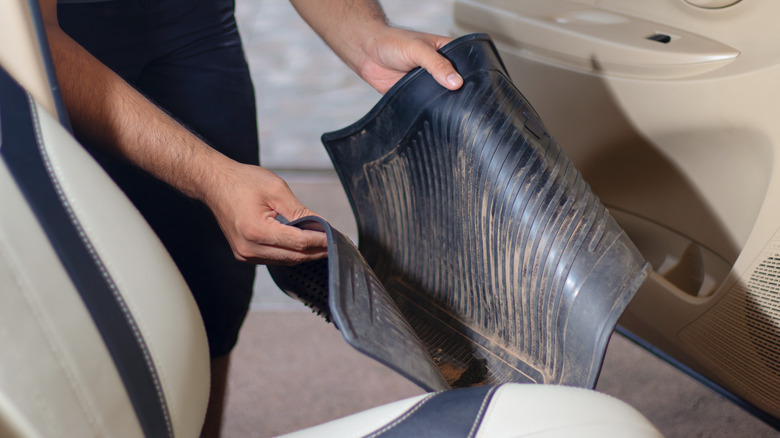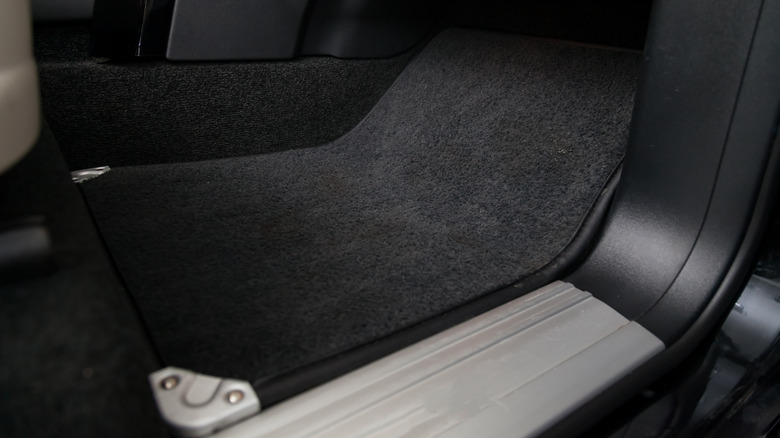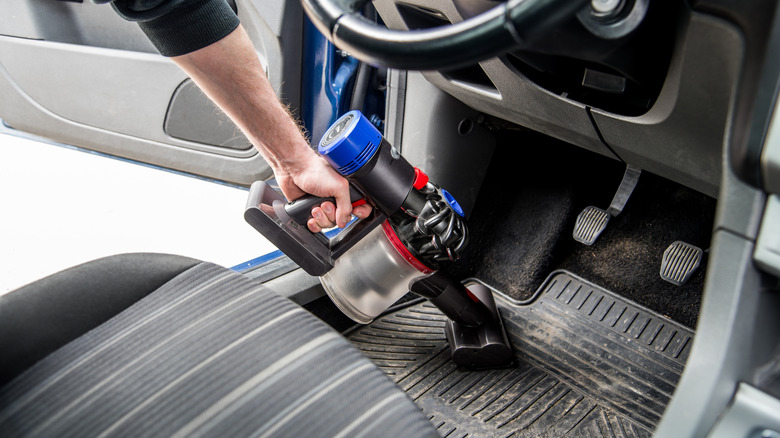Here's How To Clean Your Car Floor Mats
Among the oft-neglected parts of the car interior are the floor mats, despite the fact that they're frequently subjected to all sorts of abuse — muddy shoes, spills, crumbs, you name it. These silent guardians protect your vehicle's floor from dirt, stains, and debris, making them worthy of your attention and a little TLC. Regular cleaning of your car mat is vital as accumulated grime can cause unpleasant odors, general unsightliness, or damage to the mat material.
How can you effectively clean them and restore their appearance? Whether you have fabric, vinyl, or rubber floor mats, the first step involves getting your equipment ready. You'll need key supplies, including a scrub brush, warm water for rinsing, absorbent towels, or a sunny spot for drying the mats. A suitable cleaning solution or mild detergent for cloth mats is also handy for removing any stained areas. Lastly, a vacuum cleaner, preferably one with a brush attachment for removing loose debris and a high-pressure hose, can also help remove tough grime from vinyl and rubber mats. In the following sections, we'll delve into a more detailed explanation of the various cleaning methods.
Cleaning fabric floor mats
Natural fibers are highly absorbent by nature, which makes them more prone to stains. Loose dirt and debris can also work their way deep into the fibers, making them more challenging to clean. Cleaning these types of mats therefore requires a delicate but effective approach. A thorough shake is an important initial step in the cleaning process. Start by removing the mats from your car and giving them a good shake to dislodge loose dirt or debris. Follow this up with a vacuum, preferably with a brush attachment, to further lift away ingrained dirt.
Stains from liquids or greasy substances can also be stubborn. Using a suitable cleaner is essential to breaking down these stains without damaging the mat's fibers. The cleaning solution can be a specialized carpet cleaner or a homemade mixture of warm water and dish soap. Liberally apply your cleaner to the mat, paying particular attention to stained or heavily soiled areas. Using a scrub brush, work the cleaning solution into the mat's fibers to break down the dirt. Rinse thoroughly with warm water, ensuring all soap residue is removed.
Another challenge when cleaning cloth mats is ensuring they dry properly. If left damp, they can develop an unpleasant musty smell and even harbor mold or mildew. This is why they should be air-dried completely before being placed back in the car. You can air dry them in the sun or use a vacuum with a water extraction feature. The drying process might take longer in a humid environment, so plan accordingly.
Cleaning vinyl and rubber floor mats
Vinyl and rubber floor mats are durable and provide excellent protection against moisture, making them a great choice for those living in rainy areas or dealing with snowy conditions. They're typically more resilient to stains and less likely to absorb odors compared to cloth mats. However, their nonporous material may lead to spills sitting on the surface, creating a messy appearance. They can also develop scuff marks over time, which can be tough to remove.
Vinyl and rubber floor mats also have different cleaning processes. These durable mats can withstand a high-pressure hose and can effectively remove surface grime if your mat is heavily soiled. But you'll need to use a mild detergent and a stiff brush for tougher stains or scuff marks. Care should be taken when choosing a cleaning agent, as some harsh chemicals can cause damage to the rubber. Avoid bleach, acidic detergents, and petroleum-based solvents. Vinegar or dish soap solutions work fine, as do products marketed specifically for the material.
Scrub the mats thoroughly, then rinse with clean water, washing all soap away. Like cloth mats, vinyl, and rubber mats should still be fully dried before being placed back in the car, despite being water-resistant. This will avoid the potential for mildew growth. Air-drying or patting them down with a microfiber towel are also effective methods. The drying process is typically quicker than that of cloth mats, but they should still be completely dry to the touch before reinstalling.


